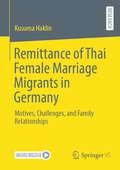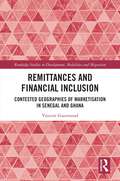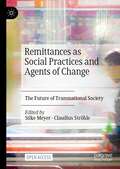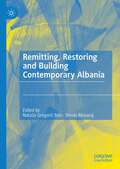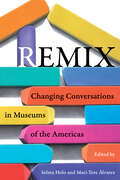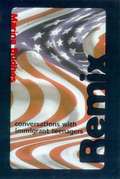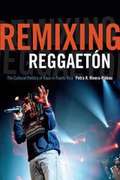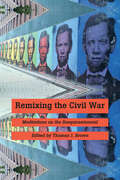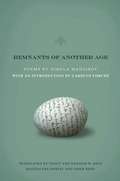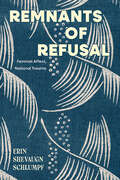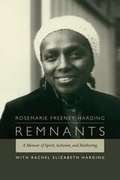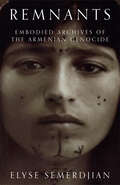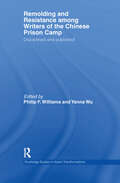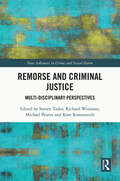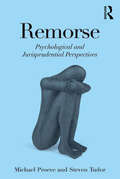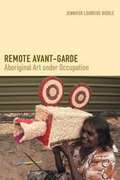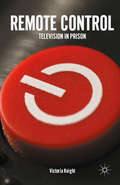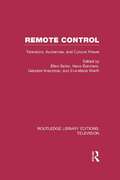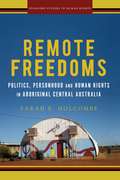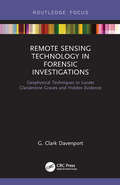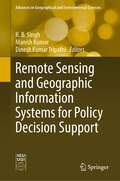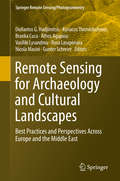- Table View
- List View
Remittance of Thai Female Marriage Migrants in Germany: Motives, Challenges, and Family Relationships
by Kusuma HaklinRemittances of Thai female married migrants have been one of the recognized conflicts among Thai-German spouses for a long time. However, the issue of remittance has only been partially debated and clarified as the economic support of Thai wives towards their natal family in Thailand. This book analyzes the determinants that influence Thai migrant wives to send remittances to their natal families and investigates the impact of remitting on both their marital and origin family relationships. The study acquired primary data from the eight key informants by a case study research approach, and supportive information from secondary informants who were personally related to the key informants. Data collection methods included interviews (in-depth and focus-groups) and observations (non-participant and participant). The findings revealed that the financial aspect is the least significant reason for sending remittances among Thai wives in Germany. The remittance practice appears to be an adoption of the cultural gratitude belief deeply rooted in Thai wives’ mentality. Thai women reported having remitted to their parents before they married and maintaining this practice as a particular way to perform their decent child’s duty towards parents while living abroad. Remitting also carried a symbolic meaning of love and care underpinned by the concept of a gratitude culture.
Remittances and Financial Inclusion: Contested Geographies of Marketisation in Senegal and Ghana (Routledge Studies in Development, Mobilities and Migration)
by Vincent GuermondThis book comprehensively explores the messy and contested relationship between everyday practices of remittance sending and receiving, processes of market making, and operations of micro- and global finance. Remittances and Financial Inclusion critically investigates a global migration-development agenda that aims to harness remittances for development by incorporating remittance flows and households into global financial circuits. The book develops a multidisciplinary perspective and combines insights from economic, development, and financial geography as well as international political economy and economic anthropology. It sets out a geographies of remittance marketisation approach to investigate the intricate and grounded ways in which remittance markets are constructed, the extent to which remittance flows and households can be (re)configured and incorporated into global finance, and why such processes are always fragile, contested, and in need of constant renegotiation. Drawing on extensive fieldwork research, the book provides an in-depth critical interrogation of the policies and initiatives that underpin remittance marketisation in Senegal, Ghana, and beyond. This volume will be especially useful to those researching and working in the areas of international development, contemporary geographies of finance and market making, and migration and remittances. It should also prove of interest to policymakers, practitioners, and activists concerned with the relation between migration, remittances, and finance in the Global South.
Remittances as Social Practices and Agents of Change: The Future of Transnational Society
by Silke Meyer Claudius StröhleThis open access book explores the transformative effects of remittances. Remittances are conceptualized as flows of money, objects, ideas, traditions, and symbolic capital, mapping out a cross-border space in which people live, work, and communicate with multiple belongings. By doing so, they effect social change both in places of origin and destination. However, their power to improve individual living conditions and community infrastructure mainly results from global inequality. Hence, we challenge the remittance mantra and go beyond the migration-development-nexus by revealing dependencies and frictions in remittance relations. Remittances are thus scrutinized in their effects on both social cohesion and social rupture. By highlighting the transformative effects of remittance in the context of conflict, climate change, and the postcolonial, we shed light on the future of transnational society.Presenting empirical case studies from Ghana, Burkina Faso, Sri Lanka, New Zealand, Turkey, Lebanon, USA, Japan, and various European countries, as well as historical North America and the Habsburg Empire, we explore remittance relations from a range of disciplines including anthropology, sociology, history, design, architecture, governance, and peace studies.
Remitting, Restoring and Building Contemporary Albania
by Smoki Musaraj Nataša Gregorič BonThe edited collection is a fresh contribution to the anthropological, sociological, and geographical explorations of time-space in Southeast Europe and Albania in particular. By delving into various levels of people’s daily lives, such as literature, relation to the environment, the urbanization process, art, photography, trauma and remembering, processes of modernity, the volume vividly portrays various realms that are lived and perceived. It largely builds on the premise that structural resemblances of the past continuously reappear in particular social and cultural moments and seek to restore and build the individual and collective lives in contemporary Albania.
Remix: Changing Conversations in Museums of the Americas
by Selma Holo and Mari-Tere ÁlvarezCelebrating the diversity of institutions in the United States, Latin America, and Canada, Remix aims to change the discourse about museums from the inside out, proposing a new, "panarchic"—nonhierarchical and adaptive—vision for museum practice. Selma Holo and Mari-Tere Álvarez offer an unconventional approach, one premised on breaching conventional systems of communication and challenging the dialogues that drive the field. Featuring more than forty authors in and around the museum world, Remix frames a series of vital case studies demonstrating how specific museums, large and small, have profoundly advanced or creatively redefined their goals to meet their ever-changing worlds. Contributors: Piedade Grinberg (Brazil), Nichole Anderson (Canada), Dr. James D. Fleck O.C. (Canada), Vanda Vitali (Canada), Lydia Bendersky (Chile), Andres Navia (Colombia), Manuel Araya-Incera (Costa Rica), Oscar Arias (Costa Rica), Alejandro de Avila Blomberg (Mexico), Marco Barerra Bassols (Mexico), Cuauhtémoc Camarena Ocampo (Mexico), Miguel Fernández Félix (Mexico), Demian Flores (Mexico), Teresa Morales (Mexico), Nelly Robles (Mexico), Hector Feliciano (Puerto Rico), Mario Vargas Llosa (Peru), Santiago Palomero Plaza (Spain), Maxwell L. Anderson (United States), Susana Bautista (United States), Graham W. J. Beal (United States), Jane Burrell (United States), Thomas P. Campbell (United States), Erica Clark (United States), Chip Colwell-Chanthaphonh (United States), Kristina van Dyke (United States), William Fox (United States), Ben Garcia (United States), Ivan Gaskell (United States), Tomas W Hanchett (United States), Richard Koshalek (United States), Clare Kunny (United States), Stephen E. Nash (United States), Joanne Northrup (United States), Jane G. Pisano (United States), Edward Rothstein (United States), Karen Satzman (United States), Lori Starr (United States), Carlos Tortolero (United States), David Wilson (United States), Fred Wilson (United States), Guillermo Barrios (Venezuela), Patricia Phelps de Cisneros (Venezuela)
Remix: Conversations with Immigrant Teenagers
by Marina BudhosPresents profiles of teenagers from countries around the world, revealing their struggles to fit into American society and their personal triumphs.
Remixing Reggaetón: The Cultural Politics of Race in Puerto Rico
by Petra R. Rivera-RideauPuerto Rico is often depicted as a "racial democracy" in which a history of race mixture has produced a racially harmonious society. In Remixing Reggaetón, Petra R. Rivera-Rideau shows how reggaetón musicians critique racial democracy's privileging of whiteness and concealment of racism by expressing identities that center blackness and African diasporic belonging. Stars such as Tego Calderón criticize the Puerto Rican mainstream's tendency to praise black culture but neglecting and marginalizing the island's black population, while Ivy Queen, the genre's most visible woman, disrupts the associations between whiteness and respectability that support official discourses of racial democracy. From censorship campaigns on the island that sought to devalue reggaetón, to its subsequent mass marketing to U.S. Latino listeners, Rivera-Rideau traces reggaetón's origins and its transformation from the music of San Juan's slums into a global pop phenomenon. Reggaetón, she demonstrates, provides a language to speak about the black presence in Puerto Rico and a way to build links between the island and the African diaspora.
Remixing the Civil War: Meditations on the Sesquicentennial
by Thomas J. BrownIn 1961, the historian and poet Robert Penn Warren remarked that "the Civil War is, for the American imagination, the great single event of our history." This volume reconsiders whether, fifty years later, Warren’s claim still holds true.Essays from specialists in art, literature, and history examine how contemporary culture represents and interprets the Civil War. They look at the works of more than thirty artists and writers as well as multiple movements—political and social—to reveal the many and provocative ways in which Americans engage the Civil War today. The book includes chapters on the place of Abraham Lincoln in Barack Obama’s presidential campaign, controversies over the symbolism of the Confederate flag, and the proliferation of "Juneteenth" observances. Remixing the Civil War pays special attention to the works of African Americans and white southerners, for whom the Civil War was a revolutionary and defining moment. Such prominent scholars as Robert H. Brinkmeyer Jr., W. Fitzhugh Brundage, Kirk Savage, and Elizabeth Young explore the works of major artists and lesser-known figures, including Bobbie Ann Mason, Kara Walker, Dario Robleto, and John Huddleston. The authors find that Americans today openly and playfully manipulate familiar images of the Civil War to explore the malleability and permeability of traditional social categories like national identity, gender, and race. This collection continues the conversation Warren began fifty years ago, although taking it in unorthodox and challenging directions, to offer fresh and stimulating perspectives on the war’s presence in the collective imagination of the nation.
Remnants of Another Age
by Carolyn Forché Nikola Madzirov"These poems move mysteriously by means of a profound inner concentration, giving expression to the deepest laws of the mind. Their linguistic 'making' is informed by vivid evidence of a serious self-making, soul-making, and heart-making. We are lucky to have these English incarnations of Nikola Madzirov."-Li-Young LeeBorn 1973 in a family of Balkan Wars refugees, Nikola Madzirov's poetry has already been translated into thirty languages and published in collections and anthologies in the United States, Europe, and Asia. A regular participant in international literary festivals, he has received several international awards including an International Writing Program fellowship at the University of Iowa. Remnants of Another Age is his first full-length American collection and carries a foreword by Carolyn Forché who writes, "Nikola Madzirov's Remnants of Another Age is aptly titled, as these poems seem to spring from elsewhere in time, reflective of a preternaturally wise and attentive sensibility. As we read these poems, they begin to inhabit us, and we are the better for having opened ourselves to them. Madzirov is a rare soul and a true poet.""I SAW DREAMS"I saw dreams that no one remembersand people wailing at the wrong graves.I saw embraces in a falling airplaneand streets with open arteries.I saw volcanoes asleep longer thanthe roots of the family treeand a child who's not afraid of the rain.Only it was me no one saw,only it was me no one saw.
Remnants of Another Age (Lannan Translations Selection Series)
by Nikola Madzirov"These poems move mysteriously by means of a profound inner concentration, giving expression to the deepest laws of the mind. Their linguistic 'making' is informed by vivid evidence of a serious self-making, soul-making, and heart-making. We are lucky to have these English incarnations of Nikola Madzirov."-Li-Young LeeBorn 1973 in a family of Balkan Wars refugees, Nikola Madzirov's poetry has already been translated into thirty languages and published in collections and anthologies in the United States, Europe, and Asia. A regular participant in international literary festivals, he has received several international awards including an International Writing Program fellowship at the University of Iowa. Remnants of Another Age is his first full-length American collection and carries a foreword by Carolyn Forché who writes, "Nikola Madzirov's Remnants of Another Age is aptly titled, as these poems seem to spring from elsewhere in time, reflective of a preternaturally wise and attentive sensibility. As we read these poems, they begin to inhabit us, and we are the better for having opened ourselves to them. Madzirov is a rare soul and a true poet.""I SAW DREAMS"I saw dreams that no one remembersand people wailing at the wrong graves.I saw embraces in a falling airplaneand streets with open arteries.I saw volcanoes asleep longer thanthe roots of the family treeand a child who's not afraid of the rain.Only it was me no one saw,only it was me no one saw.
Remnants of Refusal: Feminist Affect, National Trauma (SUNY series in Feminist Criticism and Theory)
by Erin Shevaugn SchlumpfAnalyzes how French and Chinese literary and filmic texts enact a series of feminist affective responses to the erasure of historical trauma.Remnants of Refusal traces an affective discourse of feminist refusal across a series of French and Chinese works of film and literature. Developing an inventive comparative approach, Erin Shevaugn Schlumpf argues that this discourse takes shape in response to two national traumas and their aftermath: the German Occupation and the Tiananmen Square Massacre, respectively. In both contexts, events associated with the trauma were effectively erased from the official historical record and replaced by an unwritten code of public secrecy. And, in both contexts, three affects-melancholy, ambivalence, and exhaustion-provide means of expressing mourning without breaking the taboo of direct representation. In films and literary texts by Wang Anyi, Chen Ran, Jia Zhangke, Nathalie Sarraute, Marguerite Duras, Jean-Luc Godard, and others, mourning is most frequently borne by and through the bodies of women, generating a broader feminist counternarrative to historical forgetting and burgeoning neoliberalism.
Remnants: A Memoir of Spirit, Activism, and Mothering
by Rosemarie Freeney Harding Rachel Elizabeth HardingAn activist influential in the civil rights movement, Rosemarie Freeney Harding's spirituality blended many traditions, including southern African American mysticism, Anabaptist Christianity, Tibetan Buddhism, and Afro-Brazilian Candomblé. Remnants, a multigenre memoir, demonstrates how Freeney Harding's spiritual life and social justice activism were integral to the instincts of mothering, healing, and community-building. Following Freeney Harding's death in 2004, her daughter Rachel finished this decade-long collaboration, using recorded interviews, memories of her mother, and her mother's journal entries, fiction, and previously published essays.
Remnants: Embodied Archives of the Armenian Genocide
by Elyse SemerdjianA groundbreaking and profoundly moving exploration of the Armenian genocide, told through the traces left in the memories and on the bodies of its women survivors. Foremost among the images of the Armenian Genocide is the specter of tattooed Islamized Armenian women. Blue tribal tattoos that covered face and body signified assimilation into Muslim Bedouin and Kurdish households. Among Armenians, the tattooed survivor was seen as a living ethnomartyr or, alternatively, a national stain, and the bodies of women and children figured centrally within the Armenian communal memory and humanitarian imaginary. In Remnants, these tattooed and scar-bearing bodies reveal a larger history, as the lived trauma of genocide is understood through bodies, skin, and—in what remains of those lives a century afterward—bones. With this book, Elyse Semerdjian offers a feminist reading of the Armenian Genocide. She explores how the Ottoman Armenian communal body was dis-membered, disfigured, and later re-membered by the survivor community. Gathering individual memories and archival fragments, she writes a deeply personal history, and issues a call to break open the archival record in order to embrace affect and memory. Traces of women and children rescued during and after the war are reconstructed to center the quietest voices in the historical record. This daring work embraces physical and archival remnants, the imprinted negatives of once living bodies, as a space of radical possibility within Armenian prosthetic memory and a necessary way to recognize the absence that remains.
Remodelling Communication
by Gary GenoskoCovering major developments from post-war cybernetics and telegraphy to the Internet and our networked society, Remodelling Communication explores the critical literature from across disciplines and eras on the models used for studying communications and culture.Proceeding model-by-model, Genosko provides detailed explanations of mathematical, semiotic, and reception theory's encoding/decoding models, as well as Baudrillard's critique of models and general models that bring together a variety of disciplinary perspectives. Providing a dynamic, forward-looking reorientation towards a new universe of reference, Remodelling Communication makes a significant, productive contribution to communication theory.
Remolding and Resistance Among Writers of the Chinese Prison Camp: Disciplined and published (Routledge Studies in Asia's Transformations)
by Philip Williams Yenna WuEven in the twenty-first century, the contemporary Chinese prison camp remains a more obscure and poorly understood realm than the Forbidden City of old. Apolitical service organizations such as the International Red Cross have routinely been denied access to PRC prison camps and prison camp inmates who have smuggled out frank, unofficial accounts of their incarceration have only been published overseas, and often had their sentences extended as a result. Presenting extensive analysis of literary and biographical accounts, this illuminating book provides a window to the affective side and emotional tenor of day-to-day life in modern day labour camps. With contributions from well-known and respected scholars, the book covers the contentious issues of prison economics, prisoner 'remolding' and post-traumatic stress disorder. Drawing parallels with Soviet, Nazi and Japanese prison camp practice, this outstanding new book will be invaluable to those interested in how the human mind responds to extremity, as well as to scholars of Chinese history, politics, literature and sociology.
Remorse and Criminal Justice: Multi-Disciplinary Perspectives (New Advances in Crime and Social Harm)
by Richard Weisman Michael Proeve Steven Tudor Kate RossmanithThis multidisciplinary collection brings together original contributions to present the best of current thinking about the nature and place of remorse in the context of criminal justice. Despite the wide-spread and long-standing nature of interest in offender remorse, the topic has until recently been peripheral in academic studies. The authors are scholars from North America, the UK, Europe, South Africa and Australia, from diverse academic disciplines. They reflect on the role of remorse in law, for better or for worse, on how expressions of remorse are affected by the legal contexts in which they arise, and on the impact of these expressions on the individual, the court, and the community. The work is divided into four parts – Part I Judging Remorse addresses issues concerning the task of assessing remorse in the courtroom, usually prior to determining sentence. Part II Remorse Beyond the Courtroom explores the place and significance of remorse in various post-court settings. Part III Remorse, War and Social Trauma addresses remorse in the context of political violence and social trauma in the former Yugoslavia and South Africa. Finally, Part IV Reflections seeks to underscore the multidisciplinary and interdisciplinary nature of the collection as a whole, through personal and disciplinary reflections on remorse. The work provides a showcase for how diverse academic disciplines can be brought together through a focus on a common topic. As such, the collection will become a standard reference work for further research across a range of disciplines and promote inter-disciplinary dialogue.
Remorse: Psychological and Jurisprudential Perspectives
by Michael Proeve Steven TudorRemorse is a powerful, important and yet academically neglected emotion. This book, one of the very few extended examinations of remorse, draws on psychology, law and philosophy to present a unique interdisciplinary study of this intriguing emotion. The psychological chapters examine the fundamental nature of remorse, its interpersonal effects, and its relationship with regret, guilt and shame. A practical focus is also provided in an examination of the place of remorse in psychotherapeutic interventions with criminal offenders. The book's jurisprudential chapters explore the problem of how offender remorse is proved in court and the contentious issues concerning the effect that remorse - and its absence - should have on sentencing criminal offenders. The legal and psychological perspectives are then interwoven in a discussion of the role of remorse in restorative justice. In Remorse: Psychological and Jurisprudential Perspectives, Proeve and Tudor bring together insights of neighbouring disciplines to advance our understanding of remorse. It will be of interest to theoreticians in psychology, law and philosophy, and will be of benefit to practising psychologists and lawyers.
Remote Avant-Garde: Aboriginal Art under Occupation
by Jennifer Loureide BiddleIn Remote Avant-Garde Jennifer Loureide Biddle models new and emergent desert Aboriginal aesthetics as an art of survival. Since 2007, Australian government policy has targeted "remote" Australian Aboriginal communities as at crisis level of delinquency and dysfunction. Biddle asks how emergent art responds to national emergency, from the creation of locally hunted grass sculptures to biliterary acrylic witness paintings to stop-motion animation. Following directly from the unprecedented success of the Western Desert art movement, contemporary Aboriginal artists harness traditions of experimentation to revivify at-risk vernacular languages, maintain cultural heritage, and ensure place-based practice of community initiative. Biddle shows how these new art forms demand serious and sustained attention to the dense complexities of sentient perception and the radical inseparability of art from life. Taking shape on frontier boundaries and in zones of intercultural imperative, Remote Avant-Garde presents Aboriginal art "under occupation" in Australia today.
Remote Control: Television in Prison
by V. KnightIn-cell television is now a permanent feature of prisons in England and Wales, and a key part of the experience of modern incarceration. This sociological exploration of prisoners' use of television offers an engaging and thought provoking insight into the domestic and everyday lives of people in prison - with television close at hand. Victoria Knight explores how television contributes to imprisonment by normalising the prison cell. In doing so it legitimates this space to hold prisoners for long periods of time, typically without structured activity. As a consequence, television's place in the modern prison has also come to represent an unanticipated resource in the package of care for prisoners.This book uncovers the complex and rich emotive responses to prison life. Dimensions of boredom, anger, frustration, pleasure and happiness appear through the rich narratives of both prisoners and staff, indicating the ways institutions and individuals deal with their emotions. It also offers an insight into the unfolding future of the digital world in prisons and begins to consider how the prisoner can benefit from engagement with digital technologies. It will be of great interest to practitioners and scholars of prisons and penology, as well as those interested in the impact of television on society.
Remote Control: Television in Prison
by Victoria KnightIn-cell television is now a permanent feature of prisons in England and Wales, and a key part of the experience of modern incarceration. This sociological exploration of prisoners' use of television offers an engaging and thought provoking insight into the domestic and everyday lives of people in prison - with television close at hand. Victoria Knight explores how television contributes to imprisonment by normalising the prison cell. In doing so it legitimates this space to hold prisoners for long periods of time, typically without structured activity. As a consequence, television's place in the modern prison has also come to represent an unanticipated resource in the package of care for prisoners.
Remote Control: Television, Audiences, and Cultural Power (Routledge Library Editions: Television)
by Ellen Seiter Hans Borchers Gabriele Kreutzner Eva-Maria WarthThe ways in which we watch television tell us much about our views of gender, the family and society. Bringing together the leading experts in the field of audience studies, this book investigates how viewers watch television, and what they think about the programmes they see. Originally published in 1989, the book is divided into two sections which discuss some of the theoretical issues at stake and then present case studies of a wide range of viewers: women office workers, Israeli watchers of Dallas, German families, the elderly, and American daytime soap fans. Contributors from Britain, the United States, Western Europe, Australia and Israel offer a wide range of perspectives, from feminism to post-modernism, and from semiotics to Marxism. ‘Together these essays constitute one of the best possible introductions to the leading edge of research into the phenomenon of television.’ Choice
Remote Freedoms: Politics, Personhood and Human Rights in Aboriginal Central Australia (Stanford Studies in Human Rights)
by Sarah E. HolcombeWhat does it mean to be a "rights-holder" and how does it come about? Remote Freedoms explores the contradictions and tensions of localized human rights work in very remote Indigenous communities. Based on field research with Anangu of Central Australia, this book investigates how universal human rights are understood, practiced, negotiated, and challenged in concert and in conflict with Indigenous rights. Moving between communities, government, regional NGOs, and international UN forums, Sarah E. Holcombe addresses how the notion of rights plays out within the distinctive and ambivalent sociopolitical context of Australia, and focusing specifically on Indigenous women and their experiences of violence. Can the secular modern rights-bearer accommodate the ideals of the relational, spiritual Anangu person? Engaging in a translation of the Universal Declaration of Human Rights into the local Pintupi-Luritja vernacular and observing various Indigenous interactions with law enforcement and domestic violence outreach programs, Holcombe offers new insights into our understanding of how the global rights discourse is circulated and understood within Indigenous cultures. She reveals how, in the postcolonial Australian context, human rights are double-edged: they enforce assimilation to a neoliberal social order at the same time that they empower and enfranchise the Indigenous citizen as a political actor. Remote Freedoms writes Australia's Indigenous peoples into the international debate on localizing rights in multicultural terms.
Remote Sensing Technology in Forensic Investigations: Geophysical Techniques to Locate Clandestine Graves and Hidden Evidence
by G. Clark DavenportRemote Sensing Technology in Forensic Investigations provides a basic understanding of concepts involved in the use of basic geophysical surveying, metal detectors, magnetics, electromagnetics and ground penetrating radar in police and forensic investigations. Such technology can be vital in locating clandestine, buried evidence which is often concealed in the subsurface underground. Crime scene investigation and evidence collection entails locating, identifying, collecting, and cataloging. Such physical evidence searches are time consuming and can often lead to searches that require excavations, which in itself that can destroy evidence. The noninvasive, nondestructive methods outlined in this book can both reduce the time spent on searches and excavations, thereby increasing the probability of locating vital physical evidence. As such, the application of remote sensing methods has gained increased acceptance, and seen increased usage, by investigators. Remote sensing methods are based on making indirect measurements of the surface of and within the earth. The resulting measurement information can be presented in either an imaging format— such as in aerial photography—or a non-imaging format, such as in a profile or contour map. These measurements can be interpreted to identify and characterize contrasts due to differences in physical and natural properties of the materials being studied. This can include physical evidence, remains, and clandestine graves. This book will serve as a handy introductory primer to the technology, techniques, and application of such techniques. Throughout, numerous references and additional resources are provided for those investigators, forensic anthropology, and police professionals who want further information on the technology’s usage for investigative purposes.
Remote Sensing and Geographic Information Systems for Policy Decision Support (Advances in Geographical and Environmental Sciences)
by R. B. Singh Manish Kumar Dinesh Kumar TripathiThe management of data to understand complex and interwoven processes of sustainable development has been a great challenge for researchers, planners, and decision makers. Remote sensing and GIS-based policy decision support systems not only help them to solve spatially related environmental and socio-economic issues; they also provide a powerful tool for integrating spatial and non-spatial datasets with analytical and spatial models and knowledge domains. Recent advances in the modern spatial tools of remote sensing and GIS combined with advanced computation techniques have enhanced the efficiency and capabilities of policy development. This book expands the scientific knowledge base in various physical and socio-economic issues among scholars, planners, and decision makers for policy development and research regarding sustainable development. It also demonstrates the importance of modern spatial decision support tools of remote sensing and GIS to better understand sustainable development processes and policy development. Furthermore, the book discusses case studies providing new insights as to how remote sensing and GIS-based decision support systems contribute to understanding physical and socio-economic processes and developing pragmatic policy for sustainable development.This book covers land surface temperature, hydrological processes, terrain mapping, flood and landslide hazards, land use and land cover dynamics, crime hotspots, urban health issues, tourism, agriculture, forest management, flood mitigation, urban sprawl, and village information systems, among others. Readers will find this book to be an invaluable resource for understanding and solving diverse physical and human issues for policy development related to sustainable planning and management.
Remote Sensing for Archaeology and Cultural Landscapes: Best Practices and Perspectives Across Europe and the Middle East (Springer Remote Sensing/Photogrammetry)
by Nicola Masini Rosa Lasaponara Diofantos G. Hadjimitsis Kyriacos Themistocleous Branka Cuca Athos Agapiou Vasiliki Lysandrou Gunter SchreierThis book investigates the added value that satellite technologies and remote sensing could provide for a more sustainable mapping, monitoring and management of heritage sites, be it for purposes of regular maintenance or for risk mitigation in case of natural or man-caused hazards. One of the major goals of this book is to provide a clear overview on policy perspectives, regarding both space policy as well as heritage policy, and to provide possible suggestions for common ground of these two fields, in Europe and around the world. Readers will develop a good understanding of cutting-edge applications of remote sensing and geographic information science, and the challenges that affect heritage maintenance and protection. Particular attention is given to Earth observation and remote sensing techniques applied in different locations. This book brings together innovative technologies, concrete applications and policy perspectives that can lead to a more complete vision of cultural heritage as a resource for future development of our society as a whole.
